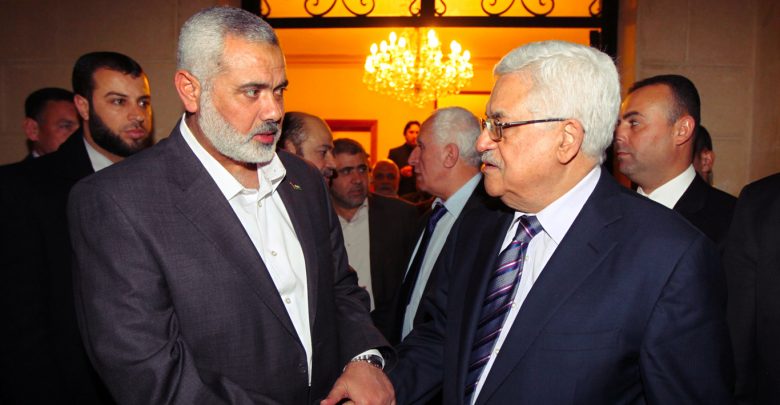
Palestinian reconciliation and real questions
Palestinian reconciliation and real questions
The desire for optimism should not lead to deviation from objectivity, honesty and sincere opinion. Otherwise, optimism would turn into illusion and deception to oneself and others. Yes, there is an important variable in the Palestinian arena regarding the state of political division that has been going on since 2007. But, could what has been done so far considered the desired Palestinian reconciliation or something else? What are the real questions that should not be forgotten amid celebrations?
First of all, let’s discuss the description of what has happened; as we cannot say that the recent intra-Palestinian understandings between Hamas and Fatah represented the targeted Palestinian “reconciliation” or even a “bilateral” or “quota” agreement between the two most prominent movements on the Palestinian arena. Moreover, we can honestly say that this is one of the latest manifestations of the break-up of the first wave of Arab revolutions which cost various parties and forces, including participants or supporters, high prices, and prompted them to change their positions and retreat at varying degrees.
The hopes and prospects that emerged in late 2010 and early 2011 received a severe blow on July 3, 2013 (Egypt’s military coup d’etat against the country’s first democratically elected civilian president) and continued to interact with many other factors, leading to:
– The fate of the revolution in Syria, the decline of the Renaissance Party in Tunisia, the siege on Qatar, the resettlement and shift of the Turkish position, and the situation of intransigence in both Yemen and Libya, up to Hamas, the last force that has maintained its status and strength despite difficulties and siege.
Hamas has always considered the national reconciliation as one of the most important conditions for the success of the national project – to concentrate on the conflict with the Israeli occupation along with all or most of Palestinian forces. However, the siege on the Gaza Strip and the continued pressure on the Islamic resistance movement at all levels turned this “reconciliation” into a precondition for easing this blockade. As long as it was – and still is – shameful to attempt to convince the Palestinians implicitly that Hamas’ administration of the Gaza Sector is responsible for the siege and restrictions imposed on them, not the occupation or those who used to close the (Rafah) crossing and prevent medical treatment, travel, and work. (The writer apparently refers here to the Egyptian regime.) However, Hamas did not have any way out except through ‘bending to the storm’. In fact, the Islamic resistance movement showed a state of keenness and insistence on the success of the reconciliation track after all.
The first real question about this track is whether it will shift from the mere assumption of power and control of Gaza to a real track of reconciliation in the Gaza Strip, including the personnel problem, ending the siege and securing the necessities of electricity and others, which President Abbas and the government seem to be “not in a hurry” to handle. It is true that objectivity requires us not to expect miracles or quick leaps, under the given difficult data, but the matter is, first and foremost, bound for the political will.
There is another question related to the previous one: Does the current “reconciliation” process include the occupied West Bank, which has over years witnessed procedures of banning, prosecuting, draining sources, imposing restrictions on individuals and closing the institutions close to Hamas and most other Palestinian factions?
One of the most important questions in the light of what has happened is whether the process is associated with a political project, which we prefer to call it “The Palestinian national project”. All that has been happening so far and in the foreseeable future are procedures and details related to the authority, the government and the administration of Gaza (and perhaps the West Bank), but as long as it does not move to discuss the national project, the Palestinian cause, how to face the occupation – with special emphasis on Jerusalem, refugees, and Palestinians in the diaspora, all what has happened – though it is important – would remain a mere de-escalating phase that would soon return to confrontation because of the conflicting goals and contradictory programs.
Perhaps, one of the most important questions is to ask about the causes of the current process, its quick pace, and its smoothness, compared with many previous rounds, despite absence of any changes of data. For years, Hamas has announced its desire to hand over ministries and Gaza administration, and called for elections of the Presidency of Palestinian Authority, the Legislative Council and the National Assembly, and has suggested for some time now the cancellation of the sector’s administrative committee. It is one of the requirements of openness and disclosure to say that the reason behind success of the recent process is that there is a regional, international, and Israeli desire (approval). This was expressed by Hamas leader Moussa Abu Marzouk when he said that “The American veto on reconciliation has been lifted.” Therefore, we should ask all parties, especially Hamas: Why has the veto been lifted now? What is the intended goal? And what is its price?
I do not like so much reference to what is called the “deal of the century” as I think it is just general ideas that do not live up to be a vision or a plan or a deal, but ultimately observers are well-aware of the Zionist and American quest to liquidate the Palestinian cause, and impose Arab-Zionist normalization. Accordingly, it was required to remove Hamas from the political equation, weaken the movement, and invest the crisis it has suffered recently. However, is there more than this? Just as we should not reject “reconciliation” because of the plans of others, our desire for true Palestinian reconciliation should not make us rule out its context and consequences.
The most prominent question is about the weapons of Hamas and the Palestinian resistance. It is inconceivable that Mr. Mahmoud Abbas (and his Arab, regional, and international supporters) might change overnight and want a full partnership with Hamas to run a national project. Rather, it is Mahmoud Abbas’s desire to ‘adapt’ and tame Hamas, and ‘subject’ it to what he wants under the terms of Oslo agreement. In fact, Abbas said this implicitly and publicly during his interview with an Egyptian media outlet after the government took over the ministries in the sector.
It is needless to say that Abbas’s talk about “unifying the weapons” in the hands of the Authority in Gaza as it is in the West Bank – despite the reported Egyptian objection and Hamas’ assertions that the matter is out of question – in fact it means that the idea of ”Palestinian national reconciliation” on the basis of full partnership and management of the conflict with the Israeli occupation Is merely an illusion under the present Palestinian administration. It also means that what we see now is only one stage that will be followed by other more stages, the target of which will be disarmament of the resistance, which requires awareness, preparation, and being always ready.
Finally, there is an important and perhaps the most important question for Hamas, related to what the movement wants in the future after easing the burden of the “rule” of Gaza. There has always been controversy over the movement’s participation in the 2006 elections under Oslo agreement. Many observers viewed this (Hamas’ involvement in the political process) as a protection for the resistance project, as it prevented its uprooting and opened up horizons in international relations, which is correct. Others thought the move caused a crisis for Hamas through its attempt to combine resistance and governance, restricting resistance to the requirements of governance and the provision of decent living for the Palestinians, which is also correct.
Regardless of which views are more likely, however the movement has exhausted most of the gains of this track and its burdens remain very heavy. I am not exaggerating when I say that this process threatens Hamas’ whole resistance project as well as the fate of the Palestinian cause. And now, there is a chance looming for the Islamic resistance movement through giving up the rule of Gaza (to restore the resistance project), despite what this carried of meanings of decline, retreat, and bending to the storm, especially as all parties believe that Hamas’ success in the 2006 elections was a “mistake” they do not want to repeat.
Therefore, Hamas needs a careful and thorough review of its course during the last 11 years, to decide on its future course, strengthen its resistance capabilities, relieve pressures practiced on it, and take the movement out of the “cloak” of Oslo. I do not say that Hamas should renounce elections or get out of the Palestinian political system completely, but there is a big difference between participation in the political decision through the PLO (for example) and representation of all Palestinians on the one hand, and restricting efforts to involvement in the “rule” of the West Bank and the Gaza Strip under Oslo agreement on the other.
The overall Palestinian political project after 24 years of Oslo failure and its catastrophic consequences for the Palestinian cause needs to be reviewed and corrected. The biggest burden in this is undoubtedly on Hamas, without ignoring the role of the other Palestinian factions, movements, institutions and personalities at home, in the Diaspora and in the territories occupied in 1948. Hamas would not be able to maintain its defense of the Palestinian cause if it was preoccupied with its own problems or if it ‘lost the compass’ for one reason or another (1 )
——————————-
footnote
(1) The views expressed in this article are entirely those of the author’s and do not necessarily reflect the views of EIPSS.




